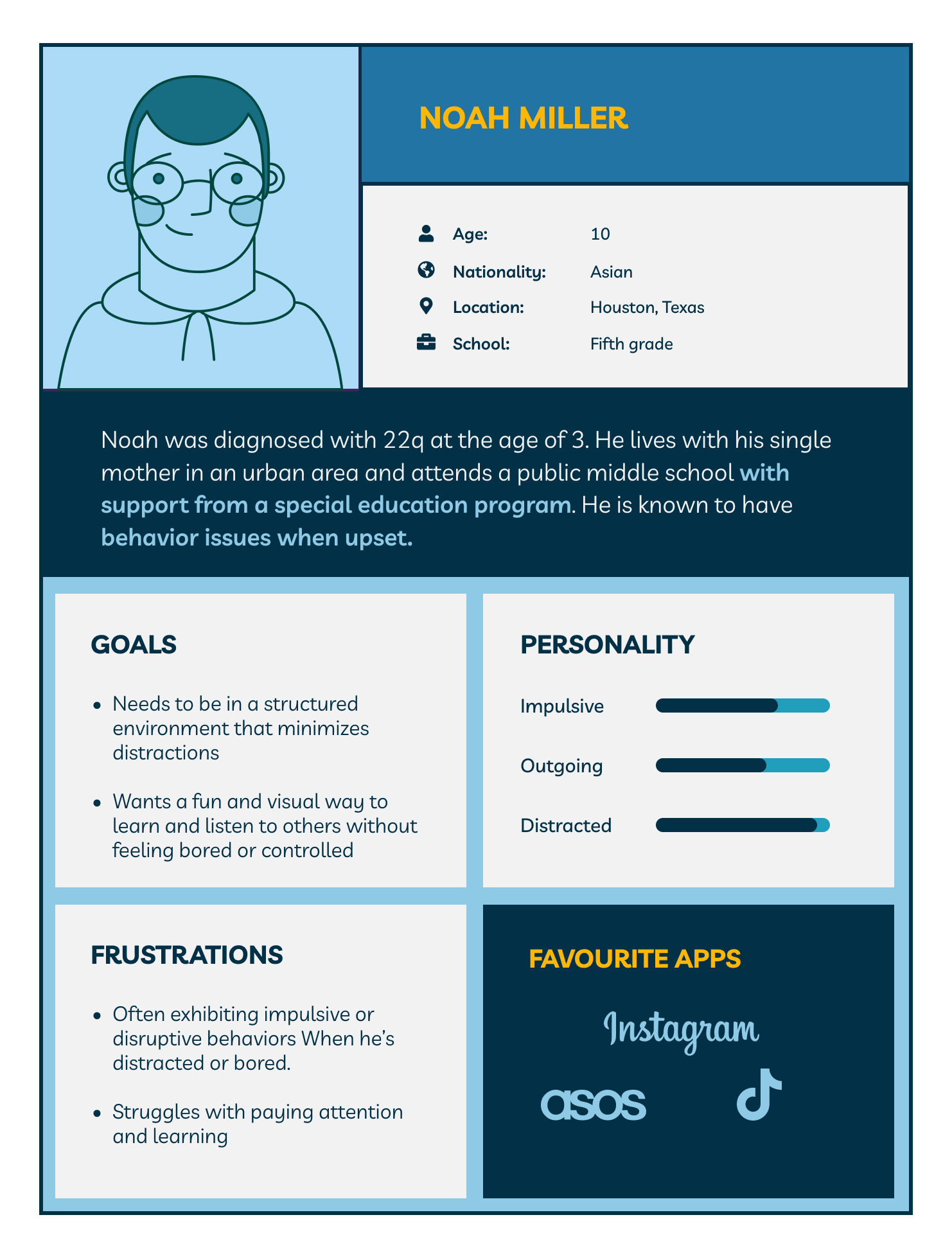
Morgan’s Wonderland Camp
THE FIRST CAMP WHERE EVERYONE CAN PLAY
About Morgan’s Wonderland Camp
Gordon Hartman founded Morgan’s Wonderland while raising his daughter, Morgan, who was born with cognitive and physical special needs. Gordon and his wife noticed there wasn’t a theme park that was fully accessible for the special needs community.
Morgan’s Wonderland camp is where children can have fun and are assisted throughout their experience. It also relieves parents to know their child is in a place free from judgment.
Challenge
22.q and DS, deletion syndrome, can result in birth defects such as missing limbs or organs, Mental disorders, and Cognitive and physical special needs. Children and adolescents may have a hard time focusing on responding to the question survey and begin to feel stressed or anxious, resulting in a breakdown or tantrum.
Strategy
Our team decided to use gamification to engage participants and promote a calm, comfortable and fun environment. Instead of responding to the survey question, participants will touch the wall that was painted with responses.
Overall Goal
The overarching goal of this study is to further characterize the 22q11.2DS endophenotype by examining the impact of stress and anxiety on immunity as well as brain development and function.
User Research
What brought our lab to Morgan’s Wonderland?
The Stress, Cognition, Affective Neuroscience Laboratory (SCAN Lab) was invited to volunteer and conduct our study to measure the effects of social anxiety and isolation on stress levels in children and adolescents with chromosome 22q11.2 deletion syndrome (22q for short) and their families.
Children diagnosed with 22.q is associated with having an increased risk of developing a psychotic disorder in adolescence, such as schizophrenia or psychotic depression. The presence of an anxiety disorder in children with 22q11.2DS is associated with adolescent-onset psychiatric disorders.
User summary
Since it was my first time attending the camp, I couldn’t interview potential participants, but there was another way. Based on previous local research studies with children and adolescents from New Orleans, we were to create a close match to give us an idea of the type of participants we might encounter.

RESULTS
Unanticipated discovery of a new audience group
There was a higher number of Hispanic families than in previous years, and our data shows a very small percentage of Hispanic families diagnosed with 22q.
Could there be a reason?
NEW PROBLEM
Since we were researching in a new environment, we realized that there were many Hispanic people, some who didn’t speak English.
Shared Stress: Hispanic parents felt more stress and guilt as they felt they failed their child.
Collectivist Culture: Participants also pointed out that Hispanic culture comes from collectivism (whereas American culture comes from individualism), which explains the feelings of guilt and high levels of stress.
SOLUTION
Only 3 members of our team are fluent Spanish, myself included, and who were raised in Spanish culture.
Language Barrier: Some guardians only speak Spanish. Most were born outside the country and some only recently migrated to give their children a better life.
PLAN
We walked around to interview each group and gather data about how they have been dealing with 22q from a Hispanic background.
Methodology
Three stations will be available, each with one type of survey (scale measures listed below), for researchers to bring a child to and ask the survey questions. Rather than responding,
Participants were excluded if they had a history of head injuries, central nervous system infections, and other focal neurologic abnormalities. The Institutional Review Board approved this research at the University of New Orleans.
RESEARCH PLAN
Participants
All participants in this research study will be children diagnosed as having chromosome 22q11.2 deletion syndrome, children and adolescents between the ages of 7 and 17, and their parent(s) or legal guardian(s).
Since the study is done on the campsite, we hypothesized 30-50 participants will complete the survey.
At the end of the study, we were able to complete 105 studies with the help of our team coordination
Testing Materials: click image for a closer look
Scale of protective factors (SPF) The Scale of Protective Factors (Ponce-Garcia, Madewell et al., 2015) is a 24-item measure of factors contributing to psychological resilience in adolescents and adults. Such factors are aspects of social relationships, confidence and planning behaviors.
The Quality of Life Scale (QOL) The QOL (McGill, 1996) measure contains 16 items addressing six conceptual domains of quality of life, such as material and physical well-being, relationships, social, community and civic activities, personal development and fulfillment, recreation, and independence.
Children’s Loneliness and Social Dissatisfaction Scale (CSLDS) The CSLDS consists of a 24-item scale including 16 primary items which screens for children’s feeling of loneliness and social satisfaction with their peer relationships.
Lubben social network scale (LSNS) The LSNS (Asher & Wheeler, 1984) is a self-reported, 6-item scale which gauges the size, type, frequency and closeness of contacts in an individual’s social network.
85% of participants who responded “Neutral, Disagree or Strongly Disagree” reported wanting to make friends but are rejected.
Being isolated makes them feel insecure and stressed
I am confident in my ability to suceed
- Strongly Agree
- Agree
- Neutral
- Disagree
- Strongly Disagree
- Strongly Agree
- Agree
- Neutral
- Disagree
- Strongly Disagree
My Family & Friends are seen as united
- Strongly Agree
- Agree
- Neutral
- Disagree
- Strongly Disagree
- Strongly Agree
- Agree
- Neutral
- Disagree
- Strongly Disagree
Participants with moderate to severe impairment are more likely to feel low self-confidence, despite if they are intelligent.
Sometimes families break apart due to high stress from the difficulties of this disorder.
Some participants are cared for by other family members or adopted
I am good at making new friends
- Strongly Agree
- Agree
- Neutral
- Disagree
- Strongly Disagree
- Strongly Agree
- Agree
- Neutral
- Disagree
- Strongly Disagree
Disclosure
Since this research is ongoing, not all the information, results, and data can be shown or shared.
The results shown here are NOT proven to be factual but merely observations from one of many research projects
Pain Points
High Stress & Anxiety
Stress & anxiety may also negatively impact neural development in children with 22q Anxiety is commonly seen in children with 22q and their families.
From birth, many children with 22q have extensive medical concerns and, with age, cognitive and social impairments become more apparent. This produces stress in both the children and their parents.
Peer Rejection
For the subscale of peer rejection, participants with 22q showed no significant difference in scoring compared to typically developing children.
Significant reports of similar symptoms
For the subscales of tense/restlessness, social anxiety, obsessive compulsions, and physical symptoms, participants with 22q were reported to have significantly high scores.
Reflection
How did your users respond?
Participants responded well to the gamification used during read-aloud surveys, but there is room for improvement. Different strategies must be used to keep previous and future participants engaged.
What's next?
Analyze this data with previous and ongoing studies to justify the end of our study
Build a bridge between the Spanish community and 22q communities.
What did you learn?
Cultural accessibility is just as crucial as taking different languages into account.
Accessibility Considerations
Culture and Language translations
















